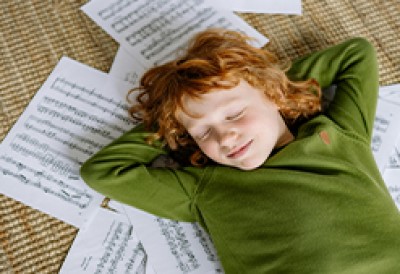Creating a peaceful atmosphere during rest time is essential for children’s emotional regulation, relaxation, and overall well-being. Music and sound choices can significantly impact how easily children transition into quiet time. The following article provides information on Why Sound Matters in Rest-Time Routines, Implementing Calming Sounds in the Environment, Recommended Playlists and more.
Why Sound Matters in Rest-Time Routines
Research indicates that sounds within 60-80 beats per minute mimic a natural resting heart rate, promoting relaxation and reduced stress. Loud or overly stimulating music can have the opposite effect, increasing restlessness and sensory overload.
Choosing the Right Sounds
To create an effective rest-time environment, consider the following options:
- Soft instrumental music – Slow piano or acoustic melodies help soothe children.
- Nature sounds – Gentle rain, ocean waves, or forest ambiance can create a calming and consistent background.
- White noise – A soft hum or subtle soundscapes minimize sudden disruptions.
- Mindfulness bells or chimes – Periodic tones can gently signal transition periods.
Implementing Calming Sounds in the Environment
Here are strategies to integrate restful sounds effectively:
- Play consistent rest-time music daily to establish a routine.
- Ensure volume is low and unobtrusive, avoiding overpowering noise.
- Combine soothing sounds with dim lighting, cozy spaces, and gentle activities.
- Observe children’s responses and adjust the environment accordingly.
Recommended Playlists
For educators looking to introduce restful sounds, here are some curated playlists:
Encouraging a Relaxing Rest-Time Culture
Beyond sound, fostering a gentle and predictable rest routine is key:
- Model calm behavior to reinforce expectations.
- Use soft verbal cues instead of loud transitions.
- Incorporate mindfulness techniques such as deep breathing or focused listening.
Further Reading
Compliance With Children's Sleep and Rest
New Indigenous Lullaby Now Available On ABC Kids For Rest Time







 As an Educator in Australia, your pay rate falls under the Children’s Services Award 2010. This award states the minimum amount that an employer can
As an Educator in Australia, your pay rate falls under the Children’s Services Award 2010. This award states the minimum amount that an employer can When working as a qualified Early Childhood Teacher (with a university degree) within a service, your rate of pay will come from the Educational Services
When working as a qualified Early Childhood Teacher (with a university degree) within a service, your rate of pay will come from the Educational Services When working as a Diploma Qualified Educator your pay rate is from the Children's Services Award 2010. This Award states your minimum rate of pay
When working as a Diploma Qualified Educator your pay rate is from the Children's Services Award 2010. This Award states your minimum rate of pay When working as a Cert 3 Qualified Educator, your pay rate is from the Children's Services Award 2010. This Award states your minimum rate of
When working as a Cert 3 Qualified Educator, your pay rate is from the Children's Services Award 2010. This Award states your minimum rate of Educational Leaders play a crucial role in their early childhood service by ensuring that the educational program aligns with best practices and supports the holistic
Educational Leaders play a crucial role in their early childhood service by ensuring that the educational program aligns with best practices and supports the holistic In early childhood education and care, ratios are more than a technicality—they are a frontline safeguard. Every child deserves responsive supervision, emotional connection, and developmental
In early childhood education and care, ratios are more than a technicality—they are a frontline safeguard. Every child deserves responsive supervision, emotional connection, and developmental Here’s a comprehensive Mobile Phone and Smart Watch Policy tailored for early childhood education and care (ECEC) services in Australia, aligned with the latest 2025
Here’s a comprehensive Mobile Phone and Smart Watch Policy tailored for early childhood education and care (ECEC) services in Australia, aligned with the latest 2025 With the new national child safety reforms kicking in on 1 September 2025, early childhood services like yours have a real opportunity to lead the
With the new national child safety reforms kicking in on 1 September 2025, early childhood services like yours have a real opportunity to lead the The Sea of Fish Challenge is a national initiative that invites children, educators, families, and communities to create and display fish artworks as a symbol
The Sea of Fish Challenge is a national initiative that invites children, educators, families, and communities to create and display fish artworks as a symbol Across the early childhood education and care sector, educators are sounding the alarm: current staffing ratios are insufficient to deliver safe, meaningful, and developmentally appropriate
Across the early childhood education and care sector, educators are sounding the alarm: current staffing ratios are insufficient to deliver safe, meaningful, and developmentally appropriate


